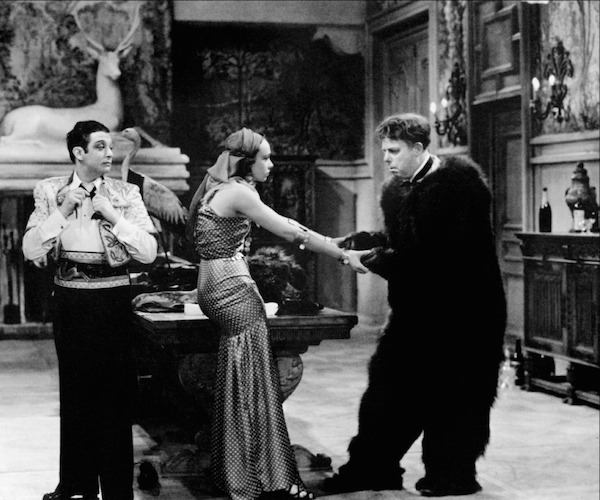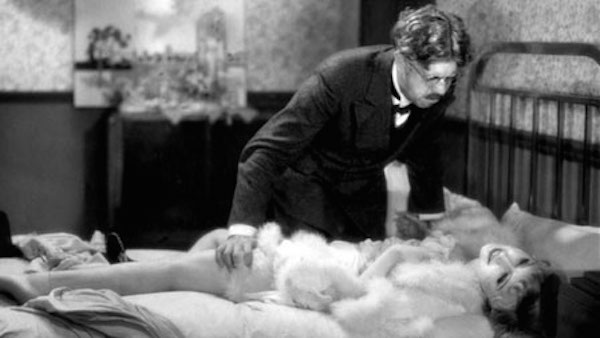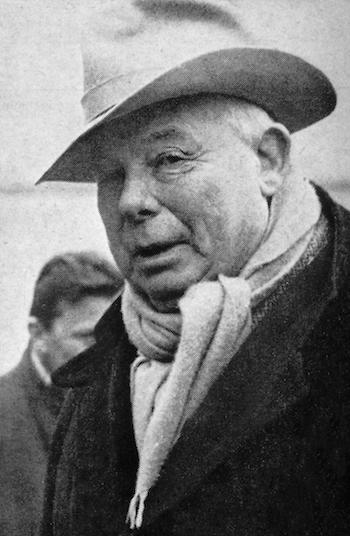Film Review: Jean Renoir’s “The Rules of the Game” — Top o’ the canon, Ma!
The Complete Jean Renoir — a definitive retrospective of films by the greatest of all directors.
“[Renoir] guided actors, but did not dictate to them. In this way, he took full advantage of each actor’s personality. His films do not look acted, but alive.”
–Production designer Eugène Lourie
“Innocence is an important part of genius.”
–Jean Renoir

A scene from Jean Renoir’s “The Rules of the Game.”
By Betsy Sherman
The Harvard Film Archive’s summer retrospective The Complete Jean Renoir, running from June 9 to Sept. 1, presents 37 films, made from 1924 to 1970, by, to me, the greatest of all directors. While recent restorations have occasioned theatrical releases for classics such as The Golden Coach and The Grand Illusion, I don’t think there’s been anything close to this retrospective in the Boston area since a 1985 not-quite-complete series at the Museum of Fine Arts, assembled as sidebar to an exhibition of works by Jean’s father, the Impressionist painter Pierre Auguste Renoir. This time, Jean is front and center. At the HFA, obscurities will complement the classics—and all but a very few will be shown on film, from archival 35mm prints.
And what riches there are from this most sensual, most liberated filmmaker, who did not believe in manipulating either his actors or his audiences. For just a partial list of the highlights, including the two mentioned above: his experimental silent Charleston Parade; two 1930s movies starring Michel Simon, La Chienne and Boudu Saved from Drowning; other 1930s films Toni, A Day in the Country, The Crime of Monsieur Lange, and La Bête humaine; from his exile in America during World War II, The Southerner, Swamp Water, and The Woman on the Beach; his ravishing drama filmed in India, The River; and the best of them all, the 1939 The Rules of the Game (La règle du jeu). This film opens the series on June 9 at 7 p.m. (it will screen again on August 27 at 4:30 p.m.).
As someone who prides herself on rooting out the obscure, the eccentric, the idiosyncratic, I bear the “curse” of having Rules as my favorite movie—a title that is squarely part of the cinephile canon. It has carried me from my late teens through middle age. Although it has always been faithful to me, I have at times betrayed it. As a college friend recently reminded me, at one reunion I was telling people my favorite movie was Evil Dead II. Sam Raimi’s 1987 comic-horror blowout is precious to me, but not exactly my favorite (coincidentally, it too is playing on June 9, as a Coolidge Corner Theatre midnight show). Each viewing of Rules gives me new insight into this mix of comedy and drama, pathos and hilarity. For complicated reasons, it was a flop when released, but seen now, this social satire sparkles.
Renoir was born in 1894 in Paris and died in 1979 in Beverly Hills. The spirit of his father’s Impressionism, with its emphasis on savoring the present moment, informed his work. Not to mention that his father’s paintings, as high price commodities, helped fund his pursuit during the 1920s, when he was learning the art form and trying (unsuccessfully) to make his first wife, Catherine Hessling, a star. By the end of the 1930s, Renoir had built up a varied body of work but, of course, moneymen saw this as inconsistency; that, coupled with the director’s independent streak, meant he had a hard time finding like-minded funders.
He wanted to make a film that expressed something about the Nazi threat and the seeming inevitability of war, but without addressing it head-on. More than 20 years after making Rules, Renoir said “I was deeply disturbed by the state of mind of French society and the world in general. It seemed to me that one way of interpreting this state of mind would be to avoid talking about it directly and tell a light-hearted story instead.” He formed a company in order to make this film, envisioned as an update of Alfred de Musset’s 1833 The Caprices of Marianne. It would also have nods to Molière, Marivaux, and Beaumarchais, especially the latter’s Marriage of Figaro with its parallel intrigues of groups of aristocrats and groups of servants (yes Downton Abbey fans, you should go see this movie). However, Renoir thought of the plays and novels on which he based his movies as mere “trampolines.” Writers Karl Koch and Camille François collaborated with Renoir on the leap that became Rules.

A scene from Jean Renoir’s “La Chienne.”
The movie’s first shot captures one phenomenon of early 20th-century technology—a radio transmitter—and moves quickly to another, an airplane. Viewers are tossed, along with a woman radio reporter, into a nocturnal mob scene. The reporter snakes toward the runway where a French aviator has landed after making a Lindbergh-like solo trans-Atlantic flight. The young man’s unexpected statement travels from his huge microphone to radios everywhere. He made this journey for the sake of a woman, and since she’s not there to greet him, she’s “disloyal.” The next shot is of a crystal radio set in a swanky Paris apartment, in the bedroom of that woman: Christine, the Marquise de la Chesnaye.
The flyer-in-the-ointment, André Jurieu, causes a ripple of distress. Christine, an Austrian who’s fairly new to Paris society, is bewildered at how the young man misinterpreted her friendly interest in him. Her worldly young maid Lisette dispenses advice on the game between the sexes. Christine’s husband of three years, Robert, shakes off with aplomb the implication of a scandalous affair. Her longtime friend Octave, through whom she met the aviator, wants her to give the possibly suicidal young man a chance.
With economy and verve Renoir and his team, including production designer Eugène Lourie and cinematographer Jean Bachelet, show us these characters and their milieu, the clothes they wear (designed by Coco Chanel) and the objects with which they surround themselves. The La Chesnaye Paris residence is filled with mirrors, which handily make the set look bigger, but also suggest a desire to expand their domain. We learn of Robert’s hobbies, which include collecting musical wind-up toys depicting all species and races.
The offshoot of this apartment is that of Robert’s mistress, Geneviève. Robert, moved by Christine’s lack of guile in the matter of André, decides to break off the affair and “be worthy of my wife.” But it won’t be easy: Geneviève’s room full of chinoiseries, including her garb, underlines the pair’s link through the exotic. The sight of each of these Parisiens framed next to an impassive Buddha is one of the film’s moments of delicious irony.
Paris is left behind for the La Chesneye château in the Loire Valley, and the upstairs-downstairs roundelay begins. A weekend of hunting is the pretext for this gathering of the couple’s friends, a mix of idle aristocrats and industrious haute bourgeois. Octave has successfully lobbied for the lovesick Jurieu to get an invite. Christine tries to nip the undercurrent of gossip in the bud, and Robert declares there will be a costume party/amateur show in honor of the young hero.
The château staff is comprised of Lisette and her fellows who labor indoors, and those who tend to the grounds, led by her husband, the gamekeeper Schumacher. With the addition to the indoor staff of Schumacher’s nemesis, the poacher Marceau—a pixie-ish interloper who soon frolics with Lisette—a romantic triangle forms. It starts as burlesque but takes on a dark cast, since Schumacher is a proto-fascist thug who alludes to vigilantism in his past and vows to exterminate the “toads” who threaten his idea of social order.

A scene from Jean Renoir’s “The Rules of the Game.”
The film’s famous centerpiece, from which it gains gravitas, is the hunt. This cruel ritual in bare-branched winter — serving only to allay boredom — is an upsetting portent of war. Infantry-like lines of batteurs invade the woods and drive rabbits and pheasants to the clearing where the armed, smartly outfitted hosts and guests wait. Expert camerawork pits the order of the slaughter against the chaos felt by the hunted, and places us in those victims’ skins: real animals that die from real bullets (yes, problematic). It feels like a transgression, and a tragedy.
More foreshadowing of death comes with a creepy skeleton romp to “Danse macabre” as part of the evening’s fête. During these theatrics, the romantic chases intersect, the one surrounding Christine (who gets drunk as a reaction to finding out about her husband’s affair) and the Lisette triangle. Considering Schumacher’s temperament, and his access to firearms, what starts as farce barrels toward fatality.
Renoir’s use of deep-focus photography contributes to our ability to explore the nooks and crannies of the movie. His preference for long-duration shots, and long-distance shots that take in much of the décor and several of the characters at one time, make it possible to let our attention hop from person to person. Certainly the film as a whole functions as a critique of blinkered thought—which can be found downstairs as well as upstairs—but Renoir, simultaneously, treats his people with love. Here are a few thumbnails of the important characters and the players who co-created them—the “friends” I’ve revisited over the years. The vivid portrayals caused François Truffaut to say the movie made him want to go back the next day to see whether things wouldn’t turn out differently.
André/Roland Toutain – André, the ballyhooed national hero of the moment, is a plot-driver. We don’t know his class background but he’s clearly an outsider to high society and its rules of the game. For Renoir, he’s the pure one among the impure. It’s too bad that he’s played by the weakest of the top-tier cast members. Roland Toutain just does not do it for me. A B-movie star and stuntman who actually could fly a plane, Toutain is bland and, for a would-be romantic contender, he comes off as peevish rather than boyishly charming. But since a key aspect of Rules is a contrarian look at heroism, Toutain’s indifferent presence could prove the point that he’s nothing special. Anyway, it doesn’t sink the ship.

Director Jean Renoir.
Octave/Jean Renoir – Renoir envisioned the role of Octave for his older brother Pierre (who stars as Inspector Maigret in Jean’s Night at the Crossroads and plays Louis XVI in La Marseillaise). However, it fell to him to take on the role and the performance is a sheer delight. Part uninhibited clown, part depressive conscience of the film, Octave was a protégé of Christine’s conductor father in Vienna, but never succeeded in forging a musical career for himself. Renoir’s limp caused by a war wound contributes to Octave’s bear-like persona. One advantage is, since most of André’s scenes are with pal Octave, Renoir can be a Sherpa guide to the lesser actor. Octave speaks the line that has come to define Renoir’s body of work and its non-judgmental ethos: “You know, on this earth, there’s one terrible thing: it’s that everyone has his reasons.”
Christine/Nora Gregor – Christine’s genuine warmth and sincerity make her, like André, an anomaly among the Parisians, for whom dissembling is like breathing air. Austrian actress Nora Gregor’s Christine is mature but endearingly naïve. When she dons Tyrolean garb for the fête, the garland of flowers on her head make her an archetype of womanliness. Gregor has several memorable lines of dialogue, which she delivers with conviction. It’s hard to believe, but true, that she did not speak French and was being fed her lines phonetically.
Robert/Marcel Dalio – Both the character of Robert and Dalio’s performance are fascinating (the actor later played the croupier in Casablanca). That the Jewish actor was cast as a marquis was one of the causes of outrage at the film in ’39. The character’s ethnicity is a source of scuttlebutt among the guests and among the servants (his mother’s family’s name, Rosenthal, is a name-check of Dalio’s character in The Grand Illusion). The marquis’ moments of unbridled joy concern his extravagant musical toys, not his wife or mistress. Robert has heart, and an open mind—his response to Octave’s line about “reasons” is to agree and add that he is against barriers—but leads a life of trivialities, surely the sort of life that alarmed Renoir, with Europe on the brink of war.
Lisette/Paulette Dubost – An unapologetic hedonist as devoted to her mistress Christine as she is indifferent to her husband Schumacher, Lisette is an important force in the story. Dubost brings expert comic chops and a mischievous twinkle. Since Christine seems to have no real woman friends in France, Lisette is her confidante. But the maid’s sense of fun never gets in the way of the code of service—a class barrier that the movie to some degree deplores, but also views with a grudging respect for its work ethic.
Marceau/Julien Carette – Comic relief par excellence, Marceau the poacher is grateful that the Marquis wants to hire him to get rid of the over-abundant rabbits—but he’d rather become a domestique. His reason, that he’d love to wear the uniform, signals the movie’s preoccupation with costumes and disguises. Carette’s sourball Parisian accent, the cigarette dangling from the corner of his mouth, and his Chaplinesque dexterity make the screen crackle. His scenes with Dalio are inspired, and have a weird mirror effect. The two actors, playing opposites on the social scale, are of similar short stature, with dark hair; the characters click into an easy rapport.
Schumacher/Gaston Modot – The gruff Alsatian gamekeeper is quickly associated with the military. He commands his “troops” during the hunt (“Flush ‘em out!”). Wife Lisette is mostly in Paris, and he’s exclusively at the country home—she likes that arrangement just fine, he doesn’t. Schumacher’s feelings for Lisette are his weakness and the only speck of humanity he has. The character could have been a cartoonish jealous buffoon, but tough guy Gaston Modot gives him a core of menace.
The version of The Rules of the Game that we see now has only been seen by the public since the ‘60s. The most complete version was shown at its disastrous 1939 premiere. Renoir used to tell the story of man who, at the premiere, set fire to a newspaper in hopes of burning down the theater. Renoir was forced to re-edit the film for its release. According to Gerald Mast, “Renoir kept cutting the pieces out of the film where the audience booed—eventually eliminating almost 20 minutes—but the audience continued to boo in new places at each showing.” Reportedly, editor (and Renoir’s romantic partner) Marguerite Houllé at one point was called in to make cuts in a cinema’s projection booth. The resounding failure of the film was painful to Renoir, who would not make another film in France until the 1950s.

A sense from Jean Renoir’s “The Picnic in the Grass,” screening with “The Rules of the Game” on June 9th at the HFA.
Rules was banned by the French government as “demoralizing,” and of course banned by the German occupiers. An Allied bombing raid destroyed the lab that held the negative of the original cut. After the war, a few severely censored prints were circulated. Then, a couple of true heroes stepped up. Jean Gaborit and Jacques Durand bought the rights to the film, located prints from all over the world and, aided by Renoir, reconstituted, nearly completely, the original (the Criterion double-disc set includes an interview with them plus a detailed comparison of versions of the film). This Rules was shown at the 1959 Venice Film Festival and its stature as a masterpiece was recognized.
Thankfully, Renoir was still around to enjoy the acclaim. He was lionized by the New Wave filmmakers and their mentor, critic André Bazin, among many others. In his later years, Renoir wrote novels, his memoirs, and a biography of his father, and he lectured on film at UCLA.
Our look at the Renoir series will continue at around its halfway point in July, with the spotlight on Renoir’s 1961 The Testament of Dr. Cordelier, an adaptation of Dr. Jekyll and Mr. Hyde starring the great Jean-Louis Barrault (The Children of Paradise).
While Octave’s “everyone has his reasons” line has stuck to any discussion of Renoir, another pithy encapsulation of the director’s work is embedded in the seldom-seen 1959 Picnic in the Grass, the movie that follows Rules on June 9 at 9:30 p.m. The film foregrounds the Apollonian vs. Dionysian theme that streaks throughout Renoir’s work, and, like many of his later films, it critiques rationalism, consumerism, and technology. The position of its protagonist, a scientist/technocrat who pushes a program of artificial insemination that he thinks will benefit mankind, is turned around by his encounter, in the rich landscape of the south of France, with a beautiful woman unencumbered by inhibitions. Actor Paul Meurisse, as the educated fool, speaks this epiphany: “Maybe happiness is submission to the natural order.”
Betsy Sherman has written about movies, old and new, for The Boston Globe, The Boston Phoenix, and The Improper Bostonian, among others. She holds a degree in archives management from Simmons Graduate School of Library and Information Science. When she grows up, she wants to be Barbara Stanwyck.
Tagged: Betsy Sherman, Harvard Film Archive, Jean Renoir, The Complete Jean Renoir, The Picnic in the Grass
